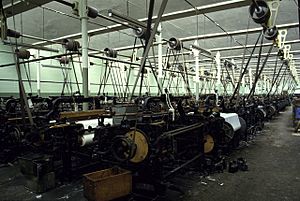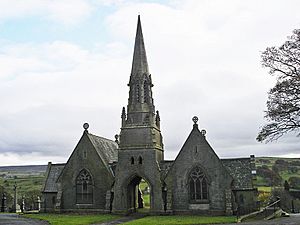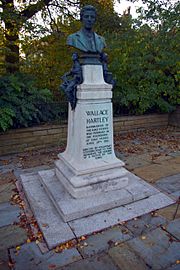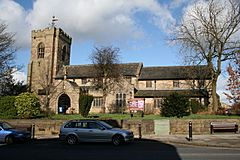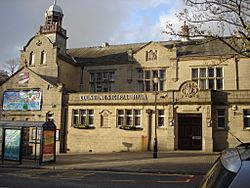Colne facts for kids
Quick facts for kids Colne |
|
|---|---|
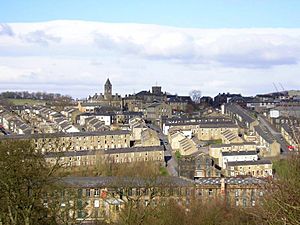 Colne, with its town hall on the horizon |
|
| Population | 17,855 (2011 Census) |
| OS grid reference | SD884399 |
| Civil parish |
|
| District |
|
| Shire county | |
| Region | |
| Country | England |
| Sovereign state | United Kingdom |
| Post town | COLNE |
| Postcode district | BB8 |
| Dialling code | 01282 |
| Police | Lancashire |
| Fire | Lancashire |
| Ambulance | North West |
| EU Parliament | North West England |
| UK Parliament |
|
Colne is a market town and civil parish in Lancashire, England. It's part of the Borough of Pendle. The town is about 3 miles (5 km) northeast of Nelson and 6 miles (10 km) northeast of Burnley.
Colne is located near the southern entrance to the Aire Gap, which is the lowest crossing point over the Pennines mountains. The M65 motorway ends west of the town. From here, main roads lead to the Yorkshire towns of Skipton and Keighley. Colne railway station is the last stop on the East Lancashire railway line.
Colne is surrounded by other parishes like Foulridge, Laneshaw Bridge, Trawden Forest, Nelson, Barrowford, and Blacko.
Contents
Colne's Long History
Early Settlements and Ancient Times
People have lived in the Colne area since the Stone Age. Scientists have found a camp from the Mesolithic period (Middle Stone Age) and a burial site from the Bronze Age nearby in Trawden. Stone tools from both the Bronze and Stone Ages have also been discovered.
High above Colne, at Castercliff, there are remains of an Iron Age fort. This fort dates back to the 6th century BC.
Roman Times and Beyond
A Roman road goes through nearby Barnoldswick, and some Roman coins have been found. However, there's no clear proof that the Romans lived in the Colne area. Some local historians still wonder if the Romans might have stayed at Castercliff.
From the early 6th century to the late 10th century, Colne was ruled by the Northumbrians and then the Vikings. By the 11th century, it was firmly under Norman control. From the 1090s until 1311, the powerful de Lacy family from Pontefract controlled the area from their base at Clitheroe Castle. The areas known as Pendle Forest and Trawden Forest come from this time. In those days, "forests" were special hunting grounds for kings and nobles.
Growth of the Market Town
St Bartholomew's Church was built before 1122. Back then, the town's market was held right in the churchyard. The churchyard used to have a market cross and wooden stocks on wheels. People who broke rules were sometimes put in these stocks on market days. Today, the stocks are in the nearby library, and the market cross is on Market Street.
Colne grew in two main parts: the town on top of the ridge, and Waterside at the bottom of the southern slope, next to Colne Water. By 1296, there were mills by the river for grinding corn and processing wool. By the 15th century, Colne became the main market town in the area. It was a big center for the wool trade, especially for making a light fabric called kersey.
Industrial Revolution and Cotton Mills
With the Industrial Revolution, making cotton became the main industry in Colne. This growth was helped by the completion of the Leeds and Liverpool Canal in 1816 and the arrival of the railway in 1848.
The market cross, which allows a market to be held, dates back to the 15th century. It has been moved a few times and is now outside the Market Hall on Market Street.
In the 1840s, there were some riots in Colne over the new police force. Violence stopped when soldiers arrived from Burnley Barracks.
Colne is on the edge of the Burnley Coalfield. Coal was mined south of the town from the early 17th century. Fox Clough Colliery, also known as Engine Pit, started around 1832. By 1891, there were 30 cotton mills in Colne, with even more in nearby areas like Trawden and Laneshaw Bridge. Some of the largest mills had thousands of looms.
How Colne is Governed
Colne used to be a small area within the larger parish of Whalley. In 1866, it became its own civil parish. Over time, Colne's local government changed. In 1895, it became a Municipal Borough, which is a type of town council.
In 1974, Colne became part of the larger Borough of Pendle. In 2008, a new Colne civil parish was created, and a town council was started again. This council meets in Colne Town Hall, which was designed by a famous architect named Alfred Waterhouse and opened in 1894.
Colne is divided into three areas called wards for local elections: Boulsworth & Foulridge, Waterside & Horsfield, and Vivary Bridge. The town is also represented on the Lancashire County Council.
The person who represents Colne in the UK Parliament is Jonathan Hinder from the Labour party. He was first elected in 2024.
Colne's Population
Colne's population changed a lot during the 20th century. It went down from about 26,000 people in 1911 to 19,000 in 1961. This was a common trend in many Lancashire towns that relied on mills.
According to the United Kingdom Census 2011, the Colne civil parish had 17,855 residents. Most people in Colne (95.8%) were White, and 3.0% were Asian. The largest religious groups were Christian (58.5%) and Muslim (2.5%). Most adults (68.5%) between 16 and 74 years old were working.
Colne's Economy
Colne's old cotton industry has mostly disappeared. Many of the textile mills have been taken down to build new shops and homes. Some old mills are still standing, but they now house different types of businesses, like manufacturing and service companies. There has been strong growth in precision engineering, especially for the aerospace industry. This is because Rolls-Royce Aerospace has a large factory nearby in Barnoldswick that makes parts for airplane engines.
The main area for businesses in Colne is Whitewalls. This area is home to many different companies, including a large meat processing plant. There has also been growth in the service sector, with offices for healthcare services.
A large ASDA supermarket and stores like Next and DFS are located in a retail park nearby. Boundary Mill Stores, one of the first factory outlets in the UK, started here in 1983. It's now the biggest employer in the borough and has stores in other cities.
Another local success story was Lyon's Tours, a family-run business that started offering overseas holidays in the 1950s. This company later became part of Airtours, which then joined the Thomas Cook Group.
Famous Landmarks in Colne
Colne is located near the Pennines mountains, so it has great views of several well-known hills. Boulsworth Hill is to the south, and Noyna Hill to the north offers views across East Lancashire and into the Yorkshire Dales. Blacko Tower (Stansfield Tower) can also be seen clearly to the northwest.
The small village of Wycoller is part of a Country Park. Cars are not allowed in the village, so it's a peaceful place. Visitors can enjoy the visitor center and the ruins of an old hall. There are many footpaths and bridleways that cross Wycoller Beck on ancient bridges, some up to 1,000 years old. You can take circular walks around Boulsworth Hill, and the long-distance Bronte Way also passes through here.
Colne is about 5 miles (8 km) east of Pendle Hill, which is probably the most famous local landmark. Many people walk up Pendle Hill, especially around Halloween, because of its connection to the Pendle witches. Some nearby farmhouses are even said to be haunted!
The town is also known for Wallace Hartley, who was the bandmaster on the RMS Titanic. A memorial was built for him on Albert Road in 1915. Wallace lived in Colne and is buried in the local cemetery.
Getting Around Colne
Train and Bus Services
Colne is connected to the national railway system. Colne railway station is about 0.75 miles (1 km) west of the town center. It's the last stop on the East Lancashire Line, which goes to Nelson, Brierfield, Burnley, and then on to Preston and Blackpool. There are plans to reopen the railway line between Colne and Skipton, but this hasn't happened yet.
The local bus company, Burnley & Pendle, runs frequent services between Burnley and Colne town center. These buses then go to other towns like Padiham, Clitheroe, Accrington, Earby, Barnoldswick, Trawden, or Keighley. There's also an hourly bus service between Skipton and Burnley that stops in Colne.
Canal Transport
The Leeds and Liverpool Canal passes northwest of Colne. After the Barrowford Locks, barges enter the highest part of the canal and then go through the 1,630-yard (1,490 m) long Foulridge Tunnel. Near the tunnel, water from three reservoirs built between 1793 and 1866 helps keep the canal level.
Education in Colne
Colne Grammar School
Colne Grammar School was an important place for education for many years. A famous former student was John Tillotson, who became an Archbishop of Canterbury (a very high position in the Church of England). The "new school" building was finished in 1941. It closed in the late 20th century when Nelson and Colne College took over the building. The red brick building was turned into apartments in 2009.
Schools for Younger Students
There are several pre-schools and primary schools in the Colne area. Some of these are:
- Colne Lord Street Primary School
- West Street Community Primary School
- Sacred Heart Catholic school
- Colne Primet Primary School
- Colne Park Primary School
- Colne Christ Church Church of England Voluntary Aided Primary School
Nearby primary schools include:
- Foulridge St Michael and All Angels CofE Voluntary Aided Primary School
- Trawden Forest Primary School
- Laneshaw Bridge Primary School
High Schools
Colne has three high schools: Colne Primet Academy, Park High School, and Ss John Fisher and Thomas More RC High School.
Colleges and Further Education
Nelson and Colne College is the main place for education after high school in the area. The college offers different qualifications like AS-levels and A-levels, as well as vocational courses. The college also works with some universities.
Religion in Colne
St Bartholomew's Church on Church Street is very old, dating back to before 1122. In 1988, it was given a Grade I listed building status, meaning it's a building of "exceptional interest" and sometimes considered important worldwide.
Other churches in Colne include Christ Church (founded 1836), Holy Trinity Church, Mount Zion United Methodist Church, St John's Methodist Church, Sacred Heart Roman Catholic Church, and Trinity Baptist Church. The Bethel Independent Methodist Church, built in 1871, was the church of Wallace Hartley, the bandmaster of the RMS Titanic.
Sports and Fun in Colne
Sports Teams
Colne F.C. is the town's football team, started in 1996. They play in the North West Counties Football League. Before them, Colne Dynamoes F.C. was a very successful team in the 1980s. Many people in Colne also support Burnley F.C., which plays in the Premier League. Colne also has a junior football club for younger players.
Colne & Nelson Rugby Union Football Club plays at Holt House Playing Fields. The club celebrated its 100th birthday in 2015 and has senior, ladies', and junior teams.
Colne Cricket Club was formed in 1830 and is the oldest cricket club in the Lancashire League. They have been a continuous member of the league since 1890.
Leisure Activities
Pendle Leisure Trust runs the Pendle Leisure Centre, which has two swimming pools, a gym, a sauna, and a sports hall. In 2013, they added "Urban Altitude," an outdoor obstacle course with high and low ropes, a zip-wire, and a climbing wall.
The nine-hole Colne Golf Club is located northeast of the town.
Colne has two large parks: King George V Playing Fields and Alkincoats Park. Alkincoats Park has bowling greens, tennis courts, pitch and putt golf, a children's play area, and paths leading to the Leeds and Liverpool Canal. The canal towpath and the old railway line (now a path) are also popular for walks. Ballgrove Picnic Area is on the eastern edge of Colne, and you can walk from there to historic Wycoller.
There's also a sailing club at Lake Burwain, one of the lakes that feeds the Leeds and Liverpool Canal.
Since 2004, Colne has hosted the annual Colne Grand Prix cycle race, which is part of British Cycling's Elite Circuit Series. Cyclists race around an 800-meter circuit in the town center. In 2013, Olympic Gold medallist Ed Clancy became the first person to win the race twice.
Roger Bannister, the first person to run a mile in under four minutes in 1954, had a father who was born in Colne. His family had lived there for 400 years.
Festivals and Entertainment
Every August, since 1989, Colne has hosted the award-winning Great British Rhythm and Blues Festival. This festival brings artists and visitors from all over the world. Many local pubs and clubs also have live music. Larger events are held at the Municipal Hall.
The Colne Gala is another festival that has been held almost every year for the past five decades, starting in 1959. It begins with a parade through the town center, which then goes to Alkincoats Park and Holt House. There, you can find live events, a fairground, charity stalls, and children's attractions.
Colne also has a lively nightlife with many restaurants and three theaters: the Pendle Hippodrome Theatre, The Municipal Hall (known as 'The Muni'), and the Little Theatre, home of the Colne Dramatic Society.
Media in Colne
The Colne area receives television from ITV Granada and BBC North West. It also has radio stations like BBC Radio Lancashire, Capital Manchester and Lancashire, and Pendle Community Radio, which is for the British Asian population in the borough.
A local newspaper, the Colne Times, is published on Fridays. A second edition, the Pendle Express, is published on Tuesdays and covers both Colne and Nelson. The town is also served by the Lancashire Telegraph and a free weekly newspaper called the 'Pendle Citizen'.
Colne and nearby Nelson are mentioned in the 1991 song, It's Grim Up North by the band The Justified Ancients of Mu Mu.
Famous People from Colne
Many notable people have connections to Colne, including:
- Lincoln Allison, an academic and writer
- Steven Burke, an Olympic cyclist who won gold medals
- John Cunliffe, the author and broadcaster who created Postman Pat and Rosie and Jim
- Natalie Gumede, an actress
- Wallace Hartley, the bandleader on the RMS Titanic
- Sir William Pickles Hartley, a famous jam manufacturer
- Neil Hodgson, a former motorcycle racer
- Mike Phelan, a former footballer and assistant manager for Manchester United
- Brian Redman, a racecar driver
- John Simm, an actor, director, and musician
- Jeff Smith, a motorcyclist who won world championships
- Andrew Stephenson, a former politician
- Alan Wharton, an England Test cricketer
- Lily Fontaine, musician and frontwoman of English Teacher
See also
 In Spanish: Colne para niños
In Spanish: Colne para niños




